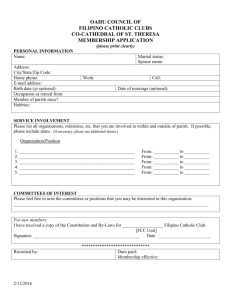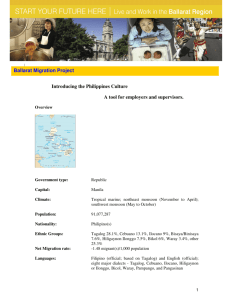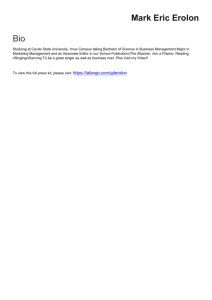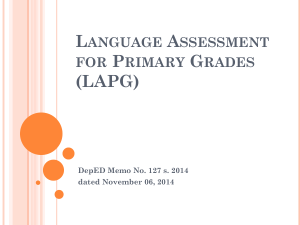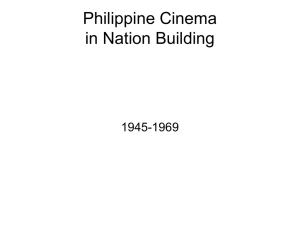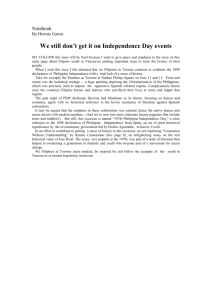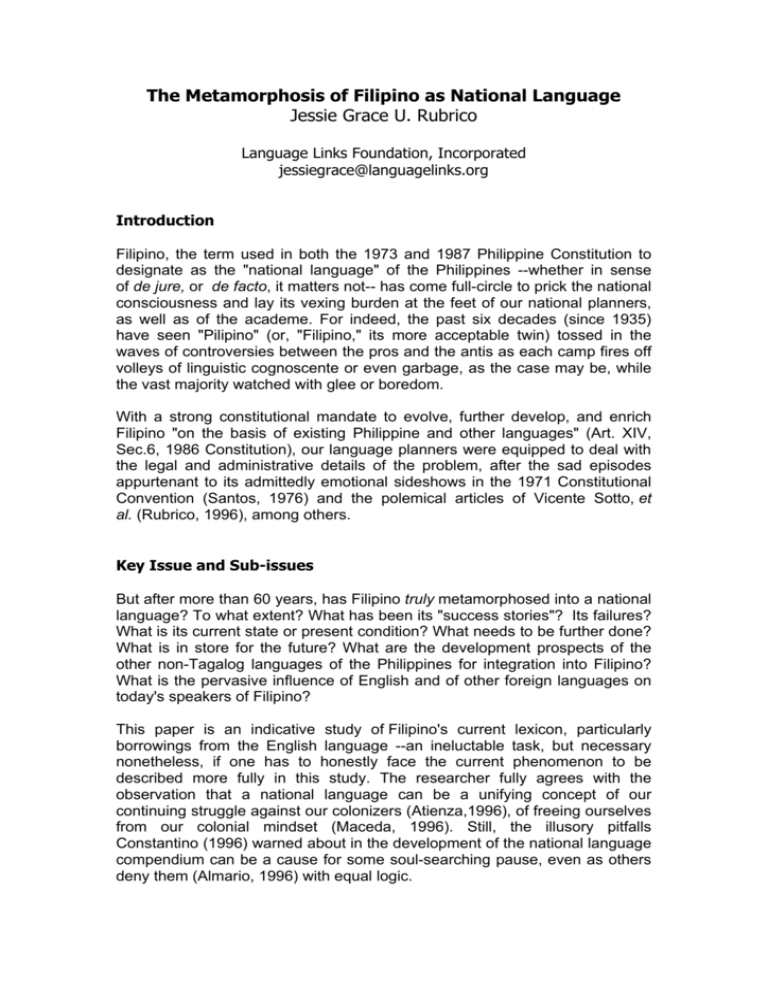
The Metamorphosis of Filipino as National Language
Jessie Grace U. Rubrico
Language Links Foundation, Incorporated
jessiegrace@languagelinks.org
Introduction
Filipino, the term used in both the 1973 and 1987 Philippine Constitution to
designate as the "national language" of the Philippines --whether in sense
of de jure, or de facto, it matters not-- has come full-circle to prick the national
consciousness and lay its vexing burden at the feet of our national planners,
as well as of the academe. For indeed, the past six decades (since 1935)
have seen "Pilipino" (or, "Filipino," its more acceptable twin) tossed in the
waves of controversies between the pros and the antis as each camp fires off
volleys of linguistic cognoscente or even garbage, as the case may be, while
the vast majority watched with glee or boredom.
With a strong constitutional mandate to evolve, further develop, and enrich
Filipino "on the basis of existing Philippine and other languages" (Art. XIV,
Sec.6, 1986 Constitution), our language planners were equipped to deal with
the legal and administrative details of the problem, after the sad episodes
appurtenant to its admittedly emotional sideshows in the 1971 Constitutional
Convention (Santos, 1976) and the polemical articles of Vicente Sotto, et
al. (Rubrico, 1996), among others.
Key Issue and Sub-issues
But after more than 60 years, has Filipino truly metamorphosed into a national
language? To what extent? What has been its "success stories"? Its failures?
What is its current state or present condition? What needs to be further done?
What is in store for the future? What are the development prospects of the
other non-Tagalog languages of the Philippines for integration into Filipino?
What is the pervasive influence of English and of other foreign languages on
today's speakers of Filipino?
This paper is an indicative study of Filipino's current lexicon, particularly
borrowings from the English language --an ineluctable task, but necessary
nonetheless, if one has to honestly face the current phenomenon to be
described more fully in this study. The researcher fully agrees with the
observation that a national language can be a unifying concept of our
continuing struggle against our colonizers (Atienza,1996), of freeing ourselves
from our colonial mindset (Maceda, 1996). Still, the illusory pitfalls
Constantino (1996) warned about in the development of the national language
compendium can be a cause for some soul-searching pause, even as others
deny them (Almario, 1996) with equal logic.
TheMetamorphosisofFilipinoasNationalLanguageRubrico1998
But if debates must continue, then let the "game" begin and may the best
argument -as perceived by its arbiters, the officials and especially the public -win. Language and culture are, after all, inseparable, with the people's lexicon
mirroring their culture.
The Corpus
Virtually everyone agrees that media -print, radio, or television (and now,
cyberspace) has a profound influence on people, especially on their language.
The Filipino spoken today, especially by the young (35 years old and below) is
undeniably distinctive and may have been influenced by media to a greater
extent. This Filipino is spoken by a significant segment of the population and it
warrants a linguistic inquiry. Selected articles from Filipino tabloids and dailies,
academic papers, candid and structured interviews of college students,
television news, sitcoms and talk shows, and radio programs in Metro Manila
are some of the culled sources for the Filipino words, phrase, or sentences
found in this study. Filipino, Tagalog, and Cebuano words are arrayed for
cognate purposes, with English as metalanguage. The corpus is found at the
end of this paper as Appendix.
The conclusion derived therefrom form the bulk of the recommendations of
this researcher, particularly on the "key success variables" that could ensure
the continuing development and metamorphosis of Filipino as the national
language of the Philippines in the next century.
Historical Perspective
The issue of our national language has been around for the past 60, or maybe
even 90, years. The inhabitants of an archipelago with over a hundred
languages need a common language with which they can communicate with
each other and express themselves as a people of one nation. The 1987
Constitution provided that, "the national language of the Philippines is Filipino.
As it evolves, it shall be further developed and enriched on the basis of
existing Philippine and other languages."
Perhaps it was unfortunate that when the Philippine Commission passed a bill
in 1908 providing for an establishment of an Institute of Philippine languages
and the training of public school teachers thereon, the Philippine Assembly
rejected it through Leon Ma. Guerrero, its Chairman on Public Instruction who
recognized the need for a common language for the Filipinos but who opted to
adopt a foreign language instead of the native ones. Through him, the
Philippine Assembly spoke, thus:
"The idea of studying the languages of the Philippine Archipelago is very
plausible; but the present aspiration of those who are interested in these
languages is to unite them or reduce them into a single language which,
based on the principal dialects of the Islands, might constitute the means
of inter-communication of ideas in the entire Archipelago, and which
2
TheMetamorphosisofFilipinoasNationalLanguageRubrico1998
might obviate the absolute need now felt of using a common foreign
tongue as a means of transmission of ideas, sentiments, and aspirations
of the inhabitants of the Philippines" (Romualdez,1936; p.302).
In 1931, the ex-officio Secretary of Public Instruction, Mr. Butte, addressing
the Catholic Women's League, encouraged the use of the vernacular as
medium of instruction in the primary grades (I to IV). He opined:
"If we may assume that one of the national objectives of the Philippines
will be to preserve the important native languages, as far as practicable,
the schools may contribute to the realization of this national objective by
abandoning English as the sole medium of instruction in the elementary
schools . . ." (Romualdez,1936).
It must be noted that Lope K. Santos addressed the First Independence
Congress on 30 February 1930 by expounding on "The Vernacular as a
Factor in National Solidarity and Independence." In 1932, Representative
Manuel V. Gallego authored Bill No. 588 which provided for the use of the
vernacular as the medium of instruction in all public elementary and
secondary schools. In 1934 and 1935, the national language issue was
discussed during the Constitutional Convention. Subsequently, the
Constitution mandated in Section 3, Article XIII: "The National Assembly shall
take steps toward the development and adoption of a common language
based on one of the existing native languages. . ."
The National Language Institute was established on 13 November1936
pursuant to Commonwealth Act No. 184. It was tasked with "the study of
Philippine dialects in general for the purpose of evolving and adopting a
common national language based on one of the existing native tongues." This
involved (1) studying each language spoken by not less than half a million
people; (2) collecting and collating cognate sets and phrases from these
languages; (3) adopting a system for Philippine phonetics and orthography;
(4) comparing critically all Philippine affixes; and (5) selecting the language
which was the most developed in structure and literature and widely accepted
and used by most Filipinos as basis for the national language (Sec. V Art.1-5).
The Institute was given a year to accomplish this.
Once the language was selected, the Institute was to prepare its grammar
and dictionary within two years. Then it should purify the language by weeding
out the unnecessary foreign words, phrases, or other grammatical
constructions, and enrich it through borrowing from the native languages and
dialects, from Spanish, and from English --in that order. And any word
adopted into the national language should be subjected to the phonological
rules and orthography of the Philippine languages.
In 1937, the Institute recommended Tagalog and came up with the Balarila
and the Tagalog - English Dictionary. In 1959, the Department of Education
called the Tagalog-based national language Pilipino. In 1965, some
congressmen took the cudgels against the propagation of Pilipino, which to
them is puristang Tagalog, as the national language. This period witnessed
3
TheMetamorphosisofFilipinoasNationalLanguageRubrico1998
the purists coining words like salumpuwit (chair), salimpapaw (airplane),
sipnayan (mathematics), etc. In 1969, some non-Tagalog speakers, like the
Madyaas Pro-Hiligaynon Society and some Cebuano groups complained
against the movement of Manila toward purismo. This gave rise to the
problems that needed to be resolved before the non-Tagalog speakers could
accept Tagalog as their own wikang pambansa (national language).
Be that as it may, the Board of National Education ordered in 1970 the
gradual shift to Pilipino as medium of instruction in the elementary starting
with Grade 1 in the school year 1974-75 and progressing into higher grades, a
level each year. It was also adopted as the medium of instruction for Rizal and
history subjects in colleges and universities. On 7 August 1973, the Board of
National Education introduced the bilingual approach to teaching --that is,
using two languages as media of instruction in schools, to wit: the vernacular
for Grades I and II, Pilipino for Grades III and IV, Pilipino and English for
secondary and tertiary levels.
This bilingual approach served to promote intellectualization of the national
language (i.e., to use it as medium of intellectual exchanges in the academe,
government offices, as well as in other disciplines in the process of acquiring
knowledge about the world which could be expressed by the said language).
In addition, it was expected to bring about a national unity and identity among
Filipinos, as they could now express themselves and communicate with each
other in a common language.
The 1973 Constitution provided that the National Assembly should endeavour
towards developing and formally adopting a common national language to be
called Filipino. Meantime, Pilipino and English were to remain official
languages unless repealed by law. Filipino was anchored on Pilipino. Pilipino
has borrowed and adopted a lot of words from the Spanish lexicon, Spain
being the country's colonizer for over 300 years. These words were carried
over to Filipino as Pilipino, as these lexical items have now undergone
phonological and morphological processes and appear to be native terms.
The borrowing from Spanish has somewhat waned, while rampant borrowing
from English prevailed. Tabloids, dailies, weeklies, showbiz magazines, even
the Cebuano weekly Bisaya borrowed heavily from English. Academicians as
well as newscasters in radio and television have adopted English words freely
and liberally (please refer to Exhibits A-F)
Filipino Today
The evolution of the Wikang Pambansa, now known as Filipino, has not
remained uneventful, as one finds out from the its historical perspective in the
previous section. From 1935 to the 1990s this language developed, first as
Tagalog-based that barely ill-disguised itself as the "national language"--a
clear victory of Manuel L. Quezon and the espousal of the tagalistas over the
Bisayan hopes of Sotto and his Ang Suga advocates; then it was called
"Pilipino" in 1959 through an executive fiat to remove the last vestiges of
"tagalogism" and imprint its national character. In 1965, the attempts of
4
TheMetamorphosisofFilipinoasNationalLanguageRubrico1998
puristas (purists) to enhance its vocabulary through artificial wordsmithing
intensified the “word war" between them and their critics; yet, the early 1970s
saw Pilipino finally being used as medium of instruction at the primary and
secondary levels of public and private schools. Subsequently, since its 1987
constitutional enshrinement as "Filipino", it has become an amalgamation of
Pilipino/Tagalog, Spanish, and English words in respelled forms.
Some lexical items given in the Appendix will now be discussed here as
representing a type of dominant Filipino written or spoken in: (a) the academe;
(b) a language journal; (c) a Cebuano weekly of general circulation; (d) an
article written by a noted Filipino linguists; (e) a series of TV news broadcasts,
and (f) some Metro Manila daily tabloids. The choice of sources for these
lexical items is rather arbitrary, albeit on firm linguistic ground that the best
sources of data are the people themselves --what they speak, what they read,
and so on. In this study, Tagalog and Cebuano speakers are taken as a
combined language group comprising more than 50 per cent of the Philippine
population (Atienza, 1996, citing NSO 1989 figures) with 92 per cent of
Filipinos being able to speak the wikang pambansa, thus effectively
establishing Filipino as the lingua franca of the country.
Exhibit A (please see Appendix) presents some lexical items used by
professors of the University of the Philippines in their publications in Filipino
on the same topic. These terms are arrayed alongside their English equivalent.
Thus, konsiderasyon is "consideration" (respelled form); natural is, likewise,
"natural" (adopted form). The original data of about 600 terms show
consistency on the aforementioned forms.
Exhibit B, with lexical items sourced from the writings of a distinguished group
of Filipino writers, exhibits the same forms --respelled, affixed, or adopted
(e.g., diyagram, kategorya, and minimal).
Exhibit C, with lexical items from the highly popular and widely-circulated
Cebuano weekly, Bisaya, shows a close congruence of Filipino usage as its
staid counterparts above (Exhibits A and B). For instance, anawonser for
"announcer," ideposito for "to deposit," and tiloring for "tailoring."
Exhibit D shows some lexical items from one of the works of the foremost
proponent of the "universal approach" to Philippine languages (Constantino,
1974). These items are unabashed borrowing from the English language,
such as fyutyur (future), vawel (vowel), tsok (chalk), sabjektiv (subjective), and
diksyunari (dictionary).
Exhibit E is a transcription of terms used in selected, highly-rated TV
newscasts in Filipino. Typically, the commentary is fast-paced, accompanied
by live "on the spot" camera footages, with words pouring out in staccato
manner, like administrasyon, kovereyj, masaker, trafik apdeyt,insedente,
aprobahan, and the like. (The respelling of these English equivalent in Filipino
is the researcher's alone, consistent with the phonological rules of Philippine
languages.)
5
TheMetamorphosisofFilipinoasNationalLanguageRubrico1998
Exhibit F lists lexical terms from the proliferating Metro Manila tabloids written
in Filipino and read by the masa, the "man in the street" literally. These are
familiar words like mentaliti (mentality), sektor (sector), isyu (issue), and
abroad (abroad).
Taken as a whole, the lexical items drawn from Exhibits A to F reveal a
common, tell-tale pattern of usage: All point to a heavy and consistent
borrowing from the English language. Why this phenomenon is so will be
explained in the next section.
Towards a Theory of Filipino
What do academicians say about Filipino? Dr. Ernesto A. Constantino, a
distinguished Filipino linguist says: "Ang pinili naming wika na idedebelop
bilang wikang pambansa natin, ang tinawag naming linggwa prangka o
Filipino." [We chose to develop as national language Filipino, that which we
refer to as the lingua franca] (1996, p.180). Atienza (1996) describes it as
"isang wikang kompromiso, o lingua franca." Flores (1996) points out that
Filipino is the language of the "kulturang popular na nagmula sa Metro Manila
at pinapalaganap sa buong kapuluan." Another view is that Filipino is the
English-Tagalog code switch (Cruz, 1997). On the other hand, Alegre (1989)
expresses that "contemporary Manila Tagalog is the basis of Filipino." He
claims that Tagalog is developing into the national language as it is the lingua
franca of the non-Tagalog provinces.
Is the Tagalog-based Pilipino really Filipino? Dr. Constantino cites the
differences between Pilipino and Filipino, to wit: Filipino (1) has more
phonemes; (2) has a different system of orthography; (3) manifests a heavy
borrowing from English; (4) has a different grammatical construction. Based
on the trend of development of Filipino as manifested in the data presented in
this study, as well as the actual usage by the linguistic trendsetters in
Philippine society --newscasters (both in radio and television), Filipino writers
and some academicians, showbiz personalities--it would appear that his
theory is closest to reality.
There is a consensus, however, among the academicians above that Filipino
is the lingua franca in Metro Manila which is inexorably pervading the regional
centers through the print and broadcast media, the songs that the local bands
sing, intellectual discussions among academicians, etc. It is the language
through which a prominent Filipino linguist communicates (Exhibit D), as well
as the medium of expression among academicians (Exhibit A), and of the
"caretakers" or "authority" of national language development in the University
of the Philippines System, namely, the writers and editors in the Sentro ng
Wikang Filipino (Exhibit B).
Even the leading Cebuano weekly, Bisaya (which has been around for the
past 68 years) has now printed on its pages loan words from English which,
more often than not, retain their original spelling despite their being subjected
to the Cebuano rules of grammar. Although borrowing from English is not
6
TheMetamorphosisofFilipinoasNationalLanguageRubrico1998
new to Cebuano,1 the fact that Bisaya does not respell the loan words at the
moment is a phenomenon worth observing. Right now the Cebuanos adopt
two alternate forms -the original spelling and the modified; soon only one form
is retained, by theory of simplification.
At the moment, it is very clear that English borrowing has a dominant and
pervading influence in the shaping of the lingua franca which is the
penultimate form of Filipino, the national language. But will this trend
continue? Language is dynamic. This researcher is of the opinion that as long
as English remains the official language of commerce, science, and
technology the trend will continue.
Unfortunately, there isn't much borrowing from other Philippine languages.
Maceda (1996) has introduced some Cebuano words and phrases in her
discourse. So natural was the insertion, the reader could contextualize the
meaning. Atienza, in the same book included in his text pakikipaglakipan, the
rootword of which, lakip, is also found in the Cebuano lexicon. At the
University of the Philippines campus, one sees Cebuano signs like Balay
Kalinaw and Ugnayan sa Pahinungod. Would a little bit more adoption of
words from other Philippine languages foster goodwill and unity among the
ethnolinguistic groups in the country in the future? Being a Cebuano, the
researcher feels proud that some Cebuano terms are now significant in the
national context. Probably members of disparate ethnolinguistic groups would
most likely feel the same.
On the other hand, there are expressed illusory hindrances to the concept of a
unifying language, to wit: (1) it is impossible to develop a national language
from one of the country's 100-plus languages; (2) the emergence of a national
language will wither other languages; (3) it is equally impossible to develop a
national language based on two or more languages; (4) regionalistic pride
prevails over nationalistic aspiration --like the Cebuano who insists on using
his own language over Filipino.
But considering the rapid linguistic development of both Cebuano and the
Metro Manila Filipino, there seems to be hope for Filipino. And this is
manifested in the perceived convergence of Pilipino and Cebuano through
their respective borrowings from English. A few examples are given below:
English Terms Pilipino Form
abroad
abroad
advertisement adbertisment
announcer
anawnser
category
kategorya
effect
epekto
Cebuano Form
abroad
adbertisment
anawonser
kategorya
epekto
Filipino (convergence)
abroad
adbertisment
anawnser
kategorya
epekto
1
Cebuano borrowing from English dates back to 1972 with Wolff’s treating as main entries in his A
Dictionary of Cebuano Visayan (1972) a number of English words which he respelled to conform with
Cebuano orthography where he adopted a three-vowel system --a. i, u. A listing of these loan words is
accessible from: http://languagelinks.org/onlinepapers/fil_wolf.html
7
TheMetamorphosisofFilipinoasNationalLanguageRubrico1998
The converging process will most likely continue, not only for Pilipino and
Cebuano but also for other Philippine languages like Hiligaynon, Bikol, Ilokano,
Waray, Kapampangan, etc. However, language change is gradual and it will
probably take several years before a substantive convergence could occur.
What is apparent for now is that the convergence is already taking place.
Meanwhile, Almario (1997, p.9) gives an update on Filipino:
"Nasa kalooban ngayon ng Filipino ang paglinang sa "sanyata" at
"ranggay" ng Iloko sa "uswag" at "bihud" ng Bisaya, sa "santing" ng
Kapampangan,"laum" at "magayon" ng Bikol at kahit sa "buntian" ng
Butanon at "suyad" ng Manobo. Samantalay hindi ito hadlang sa
madaliang pagpasok ng "shawarma" "shashimi," "glasnost,"
"perestroika," "shabu," "megabytes." "odd-even," at iba ang idadagsa ng
satelayt at FAX sa globalisasyon."
What does one make out of this assertion? Are we to believe that the process
of borrowing from other Philippine and foreign languages is now a linguistic
reality? Judging from the data gathered and presented here, perhaps this is
only partially true. That is, borrowing is almost exclusively from the English
language. And why is this so? It is difficult to give a substantive answer to this
particular question, given the limited scope of this study. Perhaps one
indication why there is a lot of borrowing from English compared to other
Philippine languages is the facility and appropriateness or applicability of
English terms to modern day-to-day living of the average urban Filipino. More
so because the urbanized Filipino is constantly exposed to the trappings -high technology, media, etc.-- of modern society which has adopted English
as its medium of communication, commerce, and education. As for Filipinos
living in rural communities, the far-reaching radio and television broadcasts
bring to them the linguistic trend emanating from the urban centers.
Thus is the metamorphosis of our national language, Filipino. Quick to adapt
and change with the times and with the demands of its speakers' culture and
politics, it had initially lain quiescent beneath the controversies and debates
over its birth and composition. But now, thanks to globalization and the rising
quality of life of the average Filipino, it has, like the moth, grown
uncomfortable inside its cocoon prison and longed for freedom of expression.
Much may yet have to be done, but Filipino as national language of unity has
arrived.
8
TheMetamorphosisofFilipinoasNationalLanguageRubrico1998
REFERENCES
Almario, V.S. (1997). Mulang Tagalog hanggang Filipino. Daluyan, 3(1-2), 1-10.
Atienza, M.E. (1996). Ang Pulitika sa Paggawa ng Palisi ng Wika. In Constantino
and Atienza (eds.) Mga Piling Diskurso sa Wika at Lipunan (pp. 133-156).
.
Quezon City: UP Press.
Constantino, E.A. (1996). Mga Linggwistik na Ilusyon sa Pilipinas. In Constantino
and Atienza (eds.). Mga Piling Diskurso sa Wika at Lipunan (pp.179-186).
.
Quezon City: UP Press.
Constantino, E.A., Sicat, R. & Cruz, P. (1974). Pilipino o Filipino? Manila: Rex
Bookstore.
Cruz, I.R. (1997). Ang Filipino sa Internet. Daluyan, 3(1-2), 69-74.
Flores, P. D. (1996). Pamamangka sa Maraming Ilog: Ang Deseminasyon ng
Filipino at ang mga Daluyan nga Kulturang Popular. In Constantino and
Atienza (eds.). Mga Piling Diskurso sa Wika at Lipunan (pp. 219230). Quezon City: UP Press.
Bisaya (Nag-unang sinemanang Magasin sa Binisaya). Oktubre 16, 1996; Marso 26,
1997; and Hunyo 25, 1997. Makati: Liwayway Publishing House.
Lopez, C. (1932). Our Language Problems. Philippine Social Science Review,
4(2), 93-100.
Maceda, T.G. (1996). Wikang Pambansa: Pagpapalaya kay Bighani. In Constantino
and Atienza (eds). Mga Piling Diskurso sa Wika at Lipunan (pp 187-194).
Quezon City: UP Press.
Romualdez, N. (1936). Our Common Tongue. PSSHR, No. 4, 302.
Rubrico, J.G.U. (1997). An Annotated Bibliography of Works and Studies on the
History, Structure, and Lexicon of the Cebuano Language: 1610 to1996.
Thesis (MA Linguistics),University of the Philippines, Diliman, Quezon City.
Santos, E. (1976). The Constitution of the Philippines: Notes and Comments.
Manila: The Philippine Society of Constitutional Law, Inc.
Copyright @1998 by Jessie Grace U. Rubrico. All rights reserved
9
TheMetamorphosisofFilipinoasNationalLanguageRubrico1998
APPENDIX
EXHIBIT A
Lexical items taken from selected articles in Constantino and Atienza, (eds.,1997)
showing English borrowing in the writings on Filipino Teresita G. Maceda, Ma. Ela L.
Atienza, Efren R. Abueg, Monico M. Atienza, Patrick D. Flores.
Table 1
English Terms
accusation
action
actual
aesthetic
analytical
appointed
appointment
acoustic
acquisition
artificial
bilingual
bilingualism
broadcast
business
capital
casual
category
categorical
chairman
chancellor
Filipino forms
akusasyon
aksyon
aktuwal
estitik
analitikal
apoynted
apoynment
akostik
akwisisyon
artipisyal
bilinggwal
bilinggwalismo
brodkast
bisnis
kapital
kaswal
kategori
kategorikal
tserman
tsanselor
English Terms
character
cluster
column
colonial
commercial
commission
commitment
committee
communication
composition
concretization
condition
connection
conscious
consideration
consonant
consultation
contemporary
context
contradiction
Filipino forms
karakter
klaster
kolum
kolonyal
komersyal
komisyon
komitment
komite
komunikasyon
komposisyon
kungkretisasyon
kondisyon
koneksyon
konsyus
konsiderasyon
konsonant
konsultasyon
kontemporaryo/i
konteksto
kontradiksyon
10
TheMetamorphosisofFilipinoasNationalLanguageRubrico1998
Table 2
English Terms
control
conversation
conviction
corpus
cosmopolitan
crisis
critical
cultural
curriculum
debate
declared
decoder
dedication
definition
deliberate
demonstration
destiny
develop
development
direction
discussion
disposition
dissemination
Filipino forms
kontrol
kumbersasyon
kumbiksyon
korpus
kosmopolitan
krisis
kritikal
kultural
kurikulum
debate
idineklara
dekoder
dedikasyon
depinisyon
delibereyt
demonstrasyon
destini
develop/debelop
debelopment
direksyon
diskasyon
disposisyon
diseminasyon
English Terms
domain
editorial
education
effective
election
electoral
elementary
elite
empirical
encoder
essential
ethnical
evolution
exception
expression
faculty
formula
forum
framework
graduate
historical
hypothesis
habit
Filipino forms
domeyn
editoryal.
edukasyon
epektibo
eleksyon/election
elektoral
elementari
elit
empirikal
enkoder
esensyal
etnikal
ebolusyon
eksepsyon
ekspresyon
fakulti
pormula
forum
preymwork
gradweyt
historikal
haypotesis
habit
Table 3
English Terms
identity
ideolect
ideological
illiterate
illiteracy
illusion
importance
imposition
impossible
individual
influential
informal
information
institution
insurrection
intellectual
intellectualization
interaction
interest
interference
interlocutor
international
intervention
Filipino forms
identidad/aydentiti
idyolek
ideolohikal
ilitereyt
iliterasi
ilusyon
importansya
imposisyon
imposible
indibidwal
impluwensyal
impormal
impormasyon
institusyon
insureksyon
intelektuwal
intelektwalisasyon
interaksyon
interes/interest
interferens
interlokutor
internasyonal
interbensyon
English Terms
ironical
issue/-d
lexicon
liberal
level
linguist
(to) manipulate
manipulating
mass media
mathematics
medium
methodical
minor
misconception
morphology
multi-ethnic
multilingual
multinational
mystification
national
natural
official
optional
Filipino forms
ironikal
isyu/nag-isyu
leksikon/lexicon
liberal
lebel
linggwist
manipulahin
pagmamanipula
mas midya
matematiks
midyum
metodikal
maynor
miskonsepsyon
morpoloji
multi-etnik
multi-linggwal
multinasyonal
mistipikasyon
nasyonal
natural
opisyal
opsyonal
11
TheMetamorphosisofFilipinoasNationalLanguageRubrico1998
Table 4
English Terms
orthography
paragraph
parochial
particle
particular
pattern
phenomena
philosophical
phoneme
phonology
physical
picket
policy
political
position
potential
possible
potential
practical
predisposition
Filipino forms
ortograpi
paragrap
parokyal
partikel
partikular
patern
penomena
pilosopikal
ponema/fonim
ponoloji
pisikal
piket
palisi
pulitikal
posisyon
potensyal
posible
potensyal
praktikal
predisposisyon
English Terms
preoccupation
property
proposition
provision
qualification
radical
recognition
refinement
reflection
register
researcher
revision
rhetorical
section
sector
sectoral
sentence
sentimental
secular
simple
Filipino forms
pre-okupasyon
properti
proposisyon
probisyon
kwalipikasyon
radikal
rekognisyon
refinement
repleksyon
rijister
resertser
rebisyon
retorikal
seksyon
sektor
sektoral
sentens
sentimental
sekular
simple
Table 5
English Terms
situation
slogan
social
social scientist
socio-cultural
socio-political
solution
spectrum
spiritual
standard
statistics
status
strata
strategic
stress
structural
subcategory
subject
superior
survey
Filipino forms
sitwasyon
slogan
sosyal
sosyal sayantist
sosyo-kultural
sosyo-politikal
solusyon
spektrum
ispiritwal
istandard
istatistiks
istatus
istrata
istratejik
istres
istruktural
sabkategori
sabjek
superyor
surbey/sarbey
English Terms
syllable
syntactic
syntax
systematical
sociological
teacher
technology
technological
textbook
theoretical
traditional
transaction
tricycle
utopian
variable
variation
variety
vernacular
version
volunteer
Filipino forms
silabol
sintaktik
sintaks
sistimatikal
sosyolohikal
titser
teknolohiya
teknolohikal
teksbuk
teoretikal
tradisyonal
transaksyon
traysikol
utopian
baryabol
baryasyon
barayti
bernakular
bersyon
boluntaryo
12
TheMetamorphosisofFilipinoasNationalLanguageRubrico1998
Exhibit B: Lexical items from the writing on Filipino by Virgilio S. Almario, Vilma M.
Resuma, Isagani R. Cruz, Aurora E. Batnag. Teresa Aquino Oreta, in Daluyan (Journal ng
Sentro ng Wikang Filipino sa Talakayang Pangwika) Vol. VIII, No. 1-2 (1997).
English Terms
academe
academic
actual
addiction
assignment
bilingual
chart
classroom
colonial
column
comic strip
committee
commonwealth
conclusion
connection
will be considered
constitutional
Filipino forms
akademya
akademiko
aktwal
adiksiyon
asaynment
bilingguwal
tsart
klasrum
kolonyal
kolum
komik istrip
komite
komonwelt
kongklusyon
koneksyon
ikokonsider
konstitusyonal
English Terms
coordinator
corpus
counselor
cultural
decision
develop
diagram
driver
efficient
elementary
evaluation
evolution
focus
forum
global
globalization
gradual
Filipino forms
koordineytor
korpus
kawnselor
kultural
desisyon
develop
diyagram
drayber
episyente
elementari
ebalwasyon
ebolusyon
fokus
forum
global
globalisasyon
gradwal
Exhibit C: Lexical items from selected 1997 issues of Bisaya showing English borrowing
in Cebuano.
English Terms
Filipino forms
English Terms
Filipino forms
abroad
action
actual
addict
album
allowance
ambition
announcer
assassin
auditorium
ballad
basketball
believe
boxing
budget
bunkrupt
calorie
chairman
character
cholesterol
classmate
coach
commander
competition
concert
condition
date (v)
decision
director
abroad
aksyon
aktuwal
adik
album
allowance
ambisyon
anawonser
assassin
awditorium
ballad
basketbol
belib
boksing
badyet
bangkrap
kalori
chairman
karakter
kolesterol
classmate/klasmet
coach
komander
kompetisyon
concert
kondisyon
magdeyt
desisyon
director
drama
driver
electronics
editorial
elevator
high school
graph
individual
information
issue
interest
journal
literacy
medium
minimal
module
official
particular
popular
profession
report
review
satellite
secondary
section
target
textbook
traditional
vernacular
drama
drayber
electronics
editoryal
elevator
hay-iskul
grap
indibidwal
impormasyon
isyu
interes
journal
literasi
midyum
minimal
modyul
opisyal
partikular
popular
propesyon
report
rebyu
satelayt
sekondari
seksyon
target
textbook
tradisyonal
bernakular
13
TheMetamorphosisofFilipinoasNationalLanguageRubrico1998
Exhibit D
Lexical items from "Ang Paggawa ng Diksyunari ng Wikang Filipino: Kung Bakit Iba ang
Wikang Filipino sa Wikang Pilipino" ni Dr. Ernesto Constantino.
English Terms
academe
adapted
affix
blackboard
causative
chalk
codification
conference
consonant
cultural
contrast
descriptive
development
factual
focus
future
history
implemented
imperative
inflection
notebook
observation
Filipino forms
akadim
inadap
afiks
blakbord
kosativ
tsok
kodifikesyon
konferens
konsonant
kultural
kontrast
deskriptiv
development
faktwal
fokus
fyutyur
histori
naimplement
imperativ
infleksyon
notbuk
obserbasyon
English Terms
obervation
optional
peacock
phoneme
prescriptive
primer
project
occasion
ortography
personal
reduplication
revision
seminar
situation
spelling
subjective
symposium
teacher
thorough
up-to-date
vowel
workshop
Filipino forms
obserbasyon
opsyonal
pikak
fonim
prespcriptive
praymer
projek
okasyon
ortografi
personal
reduplikasyon
pagrerevays
seminar
sitwasyon
ispeling
sabjektiv
simposyum
titser
toro
ap-tu-deyt
vawel
worksyap
Exhibit E
Lexical items sourced from Radyo Patrol (Channel 2), Saksi (Channel 7), Balitang Balita
(Channel 5), and the PTV News (Channel 4) showing borrowing from English. (Taken from
March 23-29, 1998 newscasts ).
airport
administration
advayser
aksyon center
alegasyon
amateur
anoynted
base
class suit
(nagko-)coach
dam
debate
desisyon
drug pusher
dyuting pulis
eleksyon
emergency power
executive report
futij
gun ban
handler
highway
hold-aper
(pangho-)hold-ap
hold-aper
institusyon
isyu
(nagki-)kleym
kondisyon
kontrobersyal
kovereyj
kwestionin
land scam
(naka-)lock
masaker
midya
network
partikular
pormal
posible
rali
report
sektor
sektoral representatib
sosyal reform
trafik apdeyt
urban center
video
14
TheMetamorphosisofFilipinoasNationalLanguageRubrico1998
Exhibit F
Lexical items from the March 26, 1998 issue of the following tabloids: Remate, Bandera,
Remate Tonight, People's Bagong Taliba, and Abante.
abroad
administrasyon
agent
akusasyon
application
aspirant
atraksiyon
assistant coach
blocking force
bakser
birth certificate
bored
budget
brutal
chairman
carnapping
champion
citizen
desisyon
director
editoryal
eleksiyon
eksposey
equipment
extension
fighter
flash alarm
forma
head coach
indikasyon
inisnab
interes
irigasyon
isyu
join
karisma
(kinu)konsider
konstitusyonal
kontneder
kontrol(in)
kriminal
krisis
(magpa-)file
(magpi-)petisyon
(makaka-)recover
make up
manedyer
movie press
nag-train
nai-table
naka-file
natural
notorious
now hiring
parti
pastoral letter
personal
pisikal
plate number
prediksyon
Copyright @1998 by Jessie Grace U. Rubrico. All rights reserved
15

